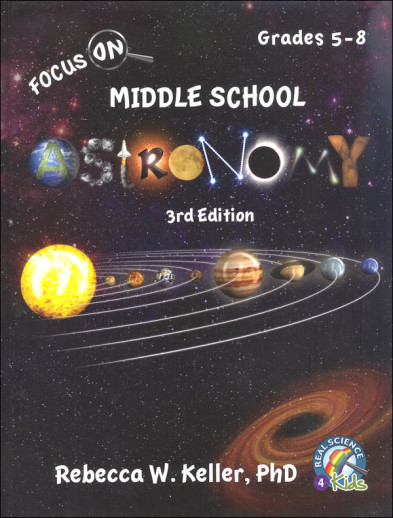We use cookies to make your experience better. To comply with the new e-Privacy directive, we need to ask for your consent to set the cookies. Learn more.
Focus On Middle School Astronomy Student Textbook - 3rd Edition (hardcover)
The Focus On Middle School Astronomy Student Textbook, 3rd Edition introduces young students to the scientific discipline of astronomy. Students will learn about the history of astronomy; various astronomical tools, including telescopes, space probes, landers, and rovers; the phases of the Moon and how the Moon affects the Earth; the Sun, solar energy, and the chemistry and physics of stars; how time is measured; using a star atlas; the life cycle of stars; the planets in our solar system and their characteristics; the Milky Way Galaxy and other galaxies; novae and supernovae; comets, asteroids, nebulae, and other objects in space; and more.
The Focus On Middle School Astronomy Student Textbook, 3rd Edition has 12 full color chapters, a glossary-index, and pronunciation guides. Grades 5-8.
148 pages.
Twelve chapters covering early and modern astronomers, the changing views of the cosmos, technology in astronomy, earth in space, the moon, sun, eclipses, chemistry and physics of stars, planets, celestial clocks, star atlas, time, planetary position, planetary orbits, asteroids/meteorites/comets, stars, galaxies, the Milky Way, spiral galaxies, barred spiral galaxies, elliptical galaxies, exploding stars, super giant stars and super novae. Lab activities use commonly found items including a computer with internet access, modeling clay in several colors, flashlight etc. Contact us for full listing.
| Product Format: | Hardcover |
|---|---|
| Grades: | 5-8 |
| Brand: | Gravitas Publications |
| Author: | Rebecca Keller |
| ISBN: | 9781941181683 |
| Length in Inches: | 11.25 |
| Width in Inches: | 8.625 |
| Height in Inches: | 0.5 |
| Weight in Pounds: | 1.75 |
Be the first to review this item


Required by COOP Group Science Instructor
Nicely illustrated, to the point chapters and is a neutral curriculum.
I purchased the entire Focus on Middle School science curriculum but wanted a textbook for myself. Very good program for someone who's homeschooling and is not a science teacher.
My 11 year old son has decided that he would like to learn about dinosaurs and astronomy this year for science.